Nursing Ethics and Law in Healthcare: A Detailed Assignment
VerifiedAdded on 2022/10/03
|5
|1166
|279
Homework Assignment
AI Summary
This assignment solution addresses key concepts in nursing ethics and law, exploring implied and explicit consent, beneficence, and patient rights. It examines scenarios where consent is implied, circumstances requiring explicit consent, and conflicts arising from the principle of beneficence. The solution provides practical responses to situations such as unsigned consent forms before surgery, parental consent for children, and respecting patient autonomy. The assignment also addresses the ethical considerations of allowing student examinations and provides relevant references. The assignment covers various aspects of patient care and ethical decision-making within the nursing profession, offering a comprehensive understanding of legal and ethical responsibilities.
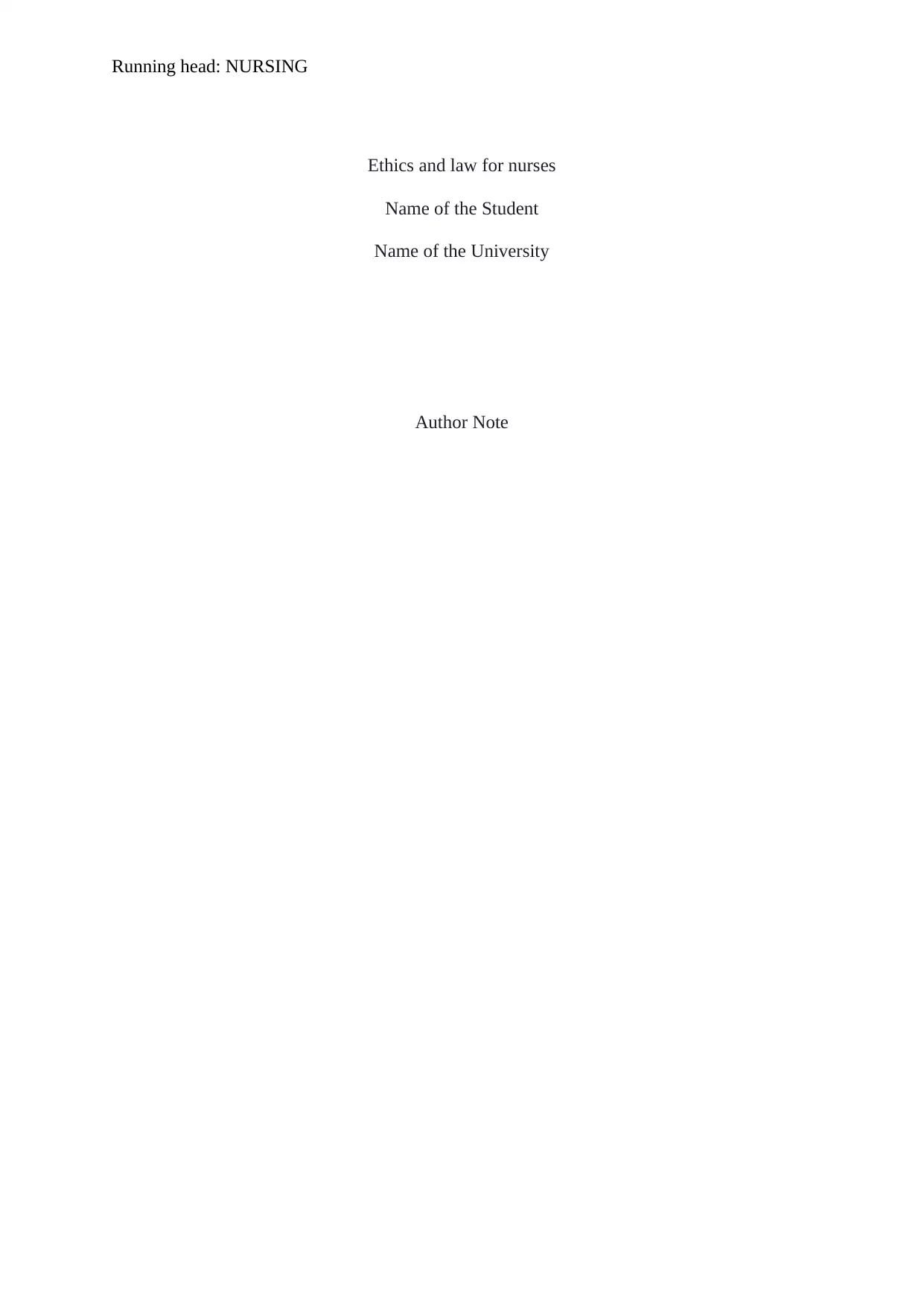
Running head: NURSING
Ethics and law for nurses
Name of the Student
Name of the University
Author Note
Ethics and law for nurses
Name of the Student
Name of the University
Author Note
Paraphrase This Document
Need a fresh take? Get an instant paraphrase of this document with our AI Paraphraser
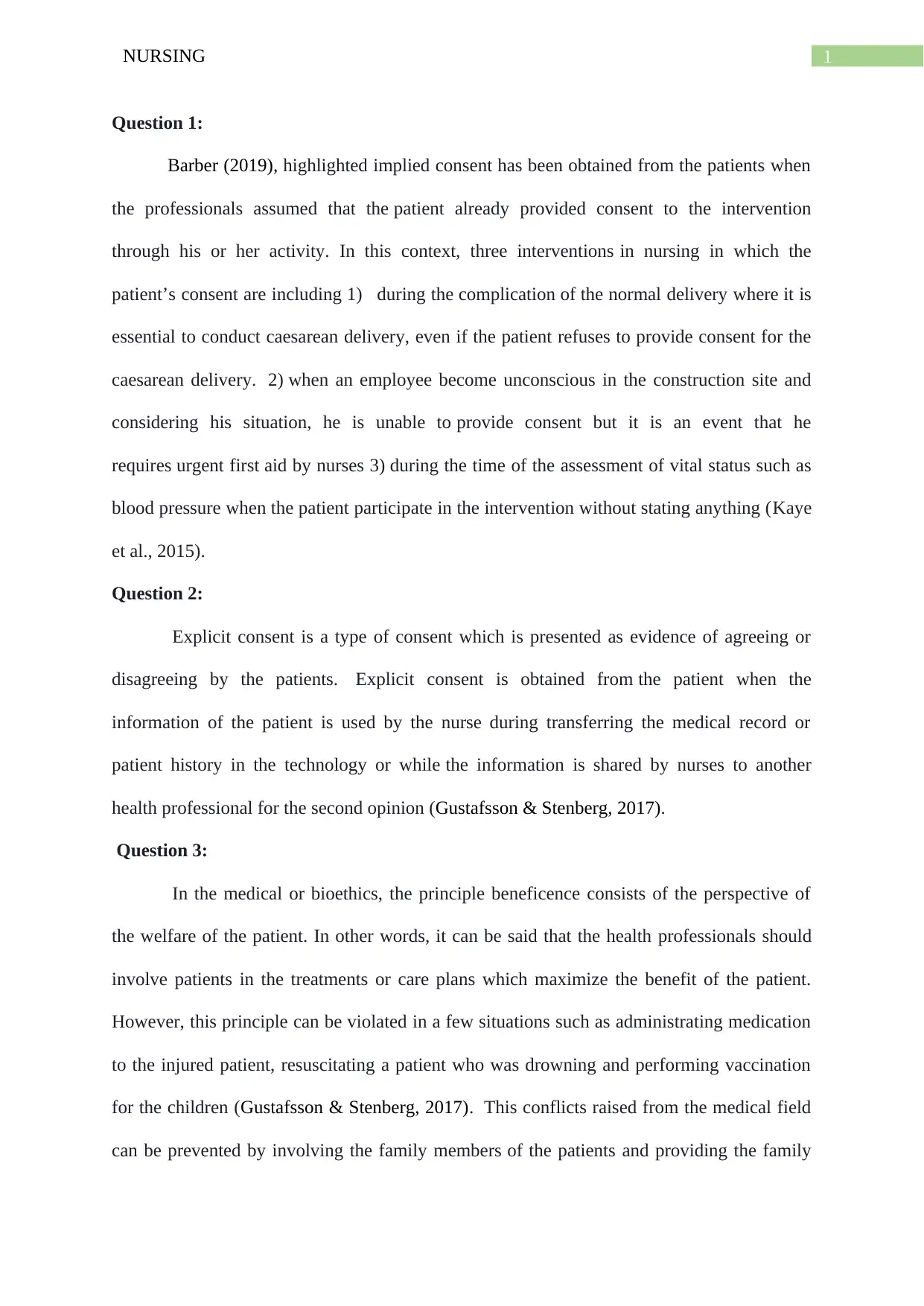
1NURSING
Question 1:
Barber (2019), highlighted implied consent has been obtained from the patients when
the professionals assumed that the patient already provided consent to the intervention
through his or her activity. In this context, three interventions in nursing in which the
patient’s consent are including 1) during the complication of the normal delivery where it is
essential to conduct caesarean delivery, even if the patient refuses to provide consent for the
caesarean delivery. 2) when an employee become unconscious in the construction site and
considering his situation, he is unable to provide consent but it is an event that he
requires urgent first aid by nurses 3) during the time of the assessment of vital status such as
blood pressure when the patient participate in the intervention without stating anything (Kaye
et al., 2015).
Question 2:
Explicit consent is a type of consent which is presented as evidence of agreeing or
disagreeing by the patients. Explicit consent is obtained from the patient when the
information of the patient is used by the nurse during transferring the medical record or
patient history in the technology or while the information is shared by nurses to another
health professional for the second opinion (Gustafsson & Stenberg, 2017).
Question 3:
In the medical or bioethics, the principle beneficence consists of the perspective of
the welfare of the patient. In other words, it can be said that the health professionals should
involve patients in the treatments or care plans which maximize the benefit of the patient.
However, this principle can be violated in a few situations such as administrating medication
to the injured patient, resuscitating a patient who was drowning and performing vaccination
for the children (Gustafsson & Stenberg, 2017). This conflicts raised from the medical field
can be prevented by involving the family members of the patients and providing the family
Question 1:
Barber (2019), highlighted implied consent has been obtained from the patients when
the professionals assumed that the patient already provided consent to the intervention
through his or her activity. In this context, three interventions in nursing in which the
patient’s consent are including 1) during the complication of the normal delivery where it is
essential to conduct caesarean delivery, even if the patient refuses to provide consent for the
caesarean delivery. 2) when an employee become unconscious in the construction site and
considering his situation, he is unable to provide consent but it is an event that he
requires urgent first aid by nurses 3) during the time of the assessment of vital status such as
blood pressure when the patient participate in the intervention without stating anything (Kaye
et al., 2015).
Question 2:
Explicit consent is a type of consent which is presented as evidence of agreeing or
disagreeing by the patients. Explicit consent is obtained from the patient when the
information of the patient is used by the nurse during transferring the medical record or
patient history in the technology or while the information is shared by nurses to another
health professional for the second opinion (Gustafsson & Stenberg, 2017).
Question 3:
In the medical or bioethics, the principle beneficence consists of the perspective of
the welfare of the patient. In other words, it can be said that the health professionals should
involve patients in the treatments or care plans which maximize the benefit of the patient.
However, this principle can be violated in a few situations such as administrating medication
to the injured patient, resuscitating a patient who was drowning and performing vaccination
for the children (Gustafsson & Stenberg, 2017). This conflicts raised from the medical field
can be prevented by involving the family members of the patients and providing the family
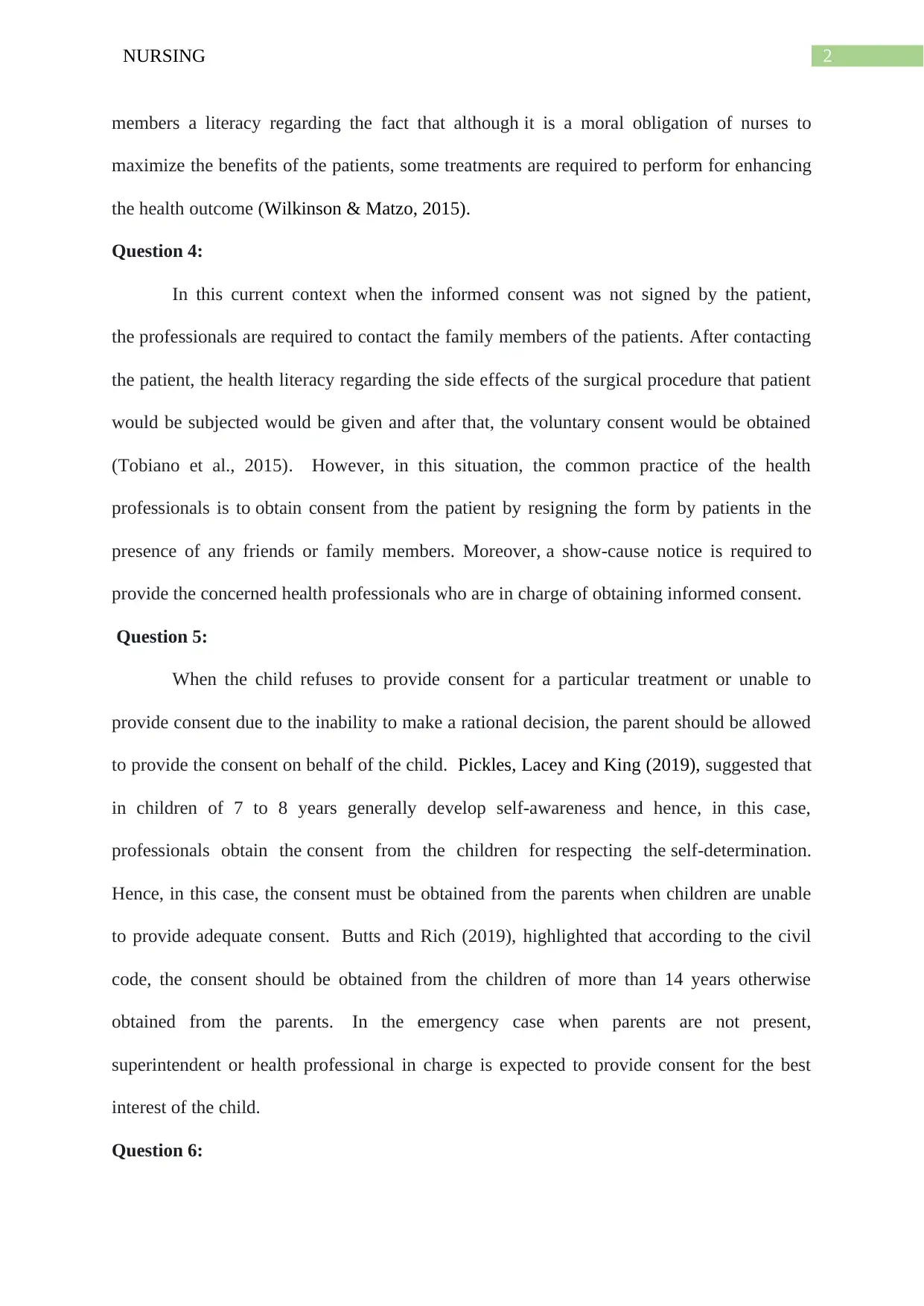
2NURSING
members a literacy regarding the fact that although it is a moral obligation of nurses to
maximize the benefits of the patients, some treatments are required to perform for enhancing
the health outcome (Wilkinson & Matzo, 2015).
Question 4:
In this current context when the informed consent was not signed by the patient,
the professionals are required to contact the family members of the patients. After contacting
the patient, the health literacy regarding the side effects of the surgical procedure that patient
would be subjected would be given and after that, the voluntary consent would be obtained
(Tobiano et al., 2015). However, in this situation, the common practice of the health
professionals is to obtain consent from the patient by resigning the form by patients in the
presence of any friends or family members. Moreover, a show-cause notice is required to
provide the concerned health professionals who are in charge of obtaining informed consent.
Question 5:
When the child refuses to provide consent for a particular treatment or unable to
provide consent due to the inability to make a rational decision, the parent should be allowed
to provide the consent on behalf of the child. Pickles, Lacey and King (2019), suggested that
in children of 7 to 8 years generally develop self-awareness and hence, in this case,
professionals obtain the consent from the children for respecting the self-determination.
Hence, in this case, the consent must be obtained from the parents when children are unable
to provide adequate consent. Butts and Rich (2019), highlighted that according to the civil
code, the consent should be obtained from the children of more than 14 years otherwise
obtained from the parents. In the emergency case when parents are not present,
superintendent or health professional in charge is expected to provide consent for the best
interest of the child.
Question 6:
members a literacy regarding the fact that although it is a moral obligation of nurses to
maximize the benefits of the patients, some treatments are required to perform for enhancing
the health outcome (Wilkinson & Matzo, 2015).
Question 4:
In this current context when the informed consent was not signed by the patient,
the professionals are required to contact the family members of the patients. After contacting
the patient, the health literacy regarding the side effects of the surgical procedure that patient
would be subjected would be given and after that, the voluntary consent would be obtained
(Tobiano et al., 2015). However, in this situation, the common practice of the health
professionals is to obtain consent from the patient by resigning the form by patients in the
presence of any friends or family members. Moreover, a show-cause notice is required to
provide the concerned health professionals who are in charge of obtaining informed consent.
Question 5:
When the child refuses to provide consent for a particular treatment or unable to
provide consent due to the inability to make a rational decision, the parent should be allowed
to provide the consent on behalf of the child. Pickles, Lacey and King (2019), suggested that
in children of 7 to 8 years generally develop self-awareness and hence, in this case,
professionals obtain the consent from the children for respecting the self-determination.
Hence, in this case, the consent must be obtained from the parents when children are unable
to provide adequate consent. Butts and Rich (2019), highlighted that according to the civil
code, the consent should be obtained from the children of more than 14 years otherwise
obtained from the parents. In the emergency case when parents are not present,
superintendent or health professional in charge is expected to provide consent for the best
interest of the child.
Question 6:
⊘ This is a preview!⊘
Do you want full access?
Subscribe today to unlock all pages.

Trusted by 1+ million students worldwide
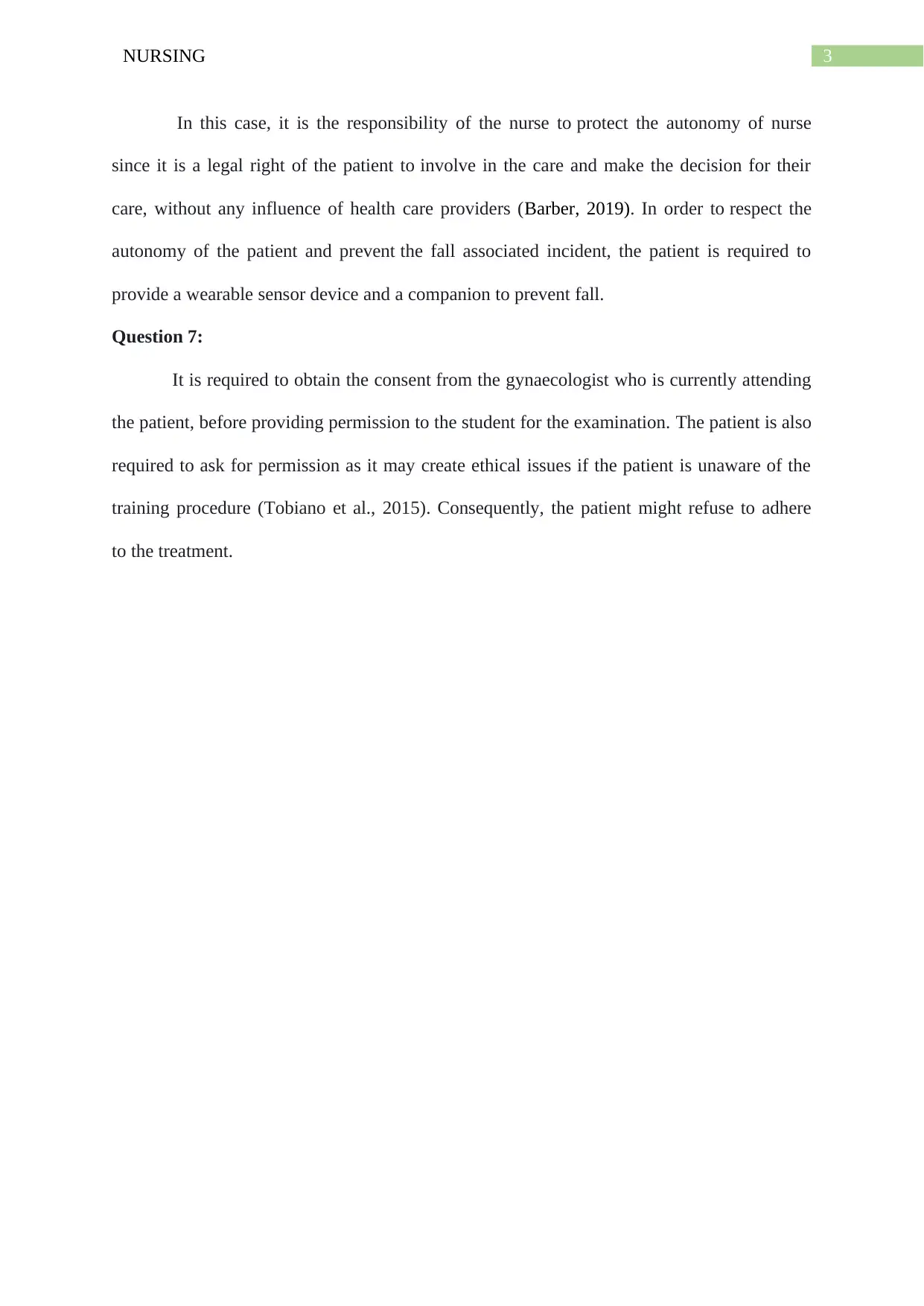
3NURSING
In this case, it is the responsibility of the nurse to protect the autonomy of nurse
since it is a legal right of the patient to involve in the care and make the decision for their
care, without any influence of health care providers (Barber, 2019). In order to respect the
autonomy of the patient and prevent the fall associated incident, the patient is required to
provide a wearable sensor device and a companion to prevent fall.
Question 7:
It is required to obtain the consent from the gynaecologist who is currently attending
the patient, before providing permission to the student for the examination. The patient is also
required to ask for permission as it may create ethical issues if the patient is unaware of the
training procedure (Tobiano et al., 2015). Consequently, the patient might refuse to adhere
to the treatment.
In this case, it is the responsibility of the nurse to protect the autonomy of nurse
since it is a legal right of the patient to involve in the care and make the decision for their
care, without any influence of health care providers (Barber, 2019). In order to respect the
autonomy of the patient and prevent the fall associated incident, the patient is required to
provide a wearable sensor device and a companion to prevent fall.
Question 7:
It is required to obtain the consent from the gynaecologist who is currently attending
the patient, before providing permission to the student for the examination. The patient is also
required to ask for permission as it may create ethical issues if the patient is unaware of the
training procedure (Tobiano et al., 2015). Consequently, the patient might refuse to adhere
to the treatment.
Paraphrase This Document
Need a fresh take? Get an instant paraphrase of this document with our AI Paraphraser
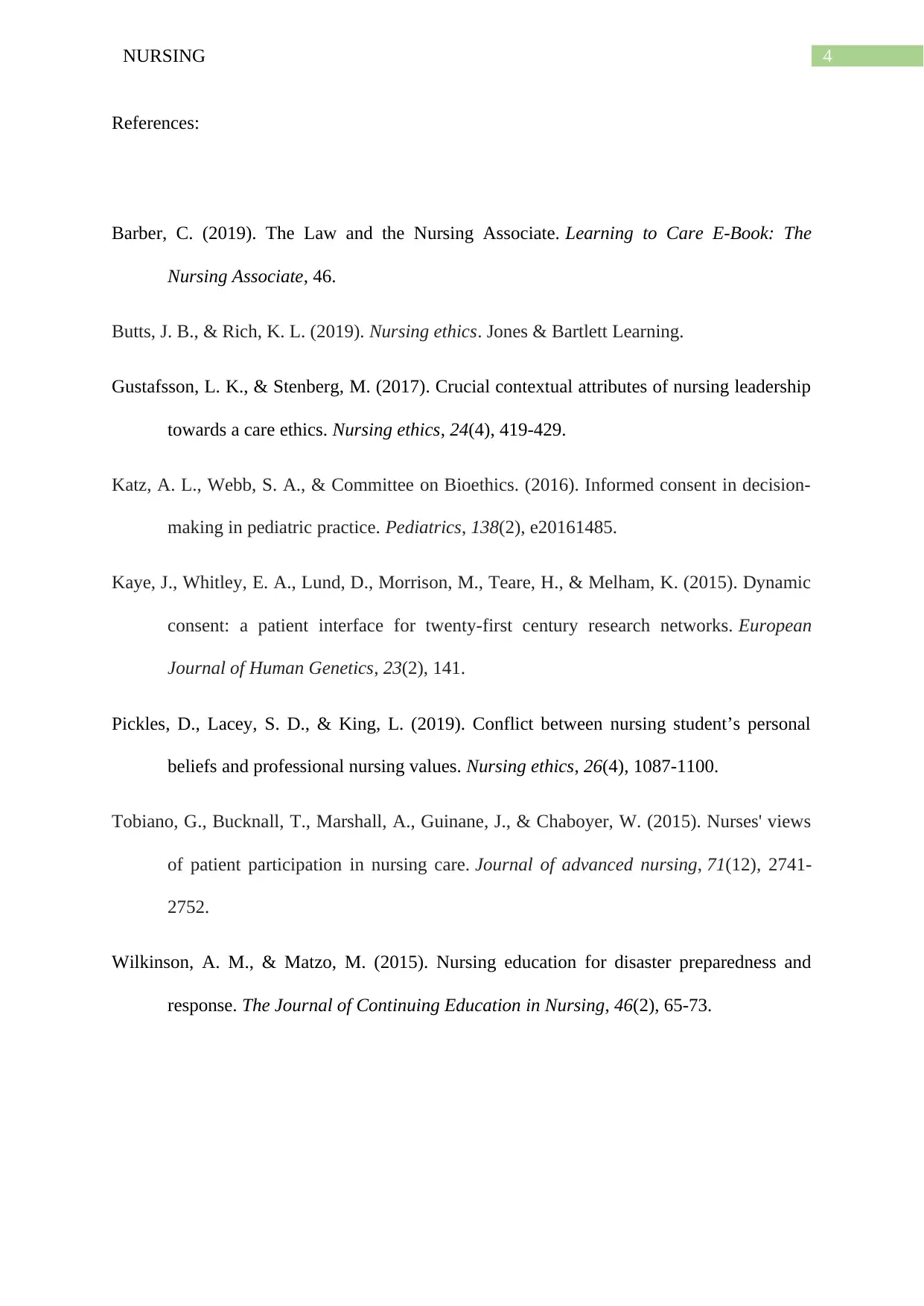
4NURSING
References:
Barber, C. (2019). The Law and the Nursing Associate. Learning to Care E-Book: The
Nursing Associate, 46.
Butts, J. B., & Rich, K. L. (2019). Nursing ethics. Jones & Bartlett Learning.
Gustafsson, L. K., & Stenberg, M. (2017). Crucial contextual attributes of nursing leadership
towards a care ethics. Nursing ethics, 24(4), 419-429.
Katz, A. L., Webb, S. A., & Committee on Bioethics. (2016). Informed consent in decision-
making in pediatric practice. Pediatrics, 138(2), e20161485.
Kaye, J., Whitley, E. A., Lund, D., Morrison, M., Teare, H., & Melham, K. (2015). Dynamic
consent: a patient interface for twenty-first century research networks. European
Journal of Human Genetics, 23(2), 141.
Pickles, D., Lacey, S. D., & King, L. (2019). Conflict between nursing student’s personal
beliefs and professional nursing values. Nursing ethics, 26(4), 1087-1100.
Tobiano, G., Bucknall, T., Marshall, A., Guinane, J., & Chaboyer, W. (2015). Nurses' views
of patient participation in nursing care. Journal of advanced nursing, 71(12), 2741-
2752.
Wilkinson, A. M., & Matzo, M. (2015). Nursing education for disaster preparedness and
response. The Journal of Continuing Education in Nursing, 46(2), 65-73.
References:
Barber, C. (2019). The Law and the Nursing Associate. Learning to Care E-Book: The
Nursing Associate, 46.
Butts, J. B., & Rich, K. L. (2019). Nursing ethics. Jones & Bartlett Learning.
Gustafsson, L. K., & Stenberg, M. (2017). Crucial contextual attributes of nursing leadership
towards a care ethics. Nursing ethics, 24(4), 419-429.
Katz, A. L., Webb, S. A., & Committee on Bioethics. (2016). Informed consent in decision-
making in pediatric practice. Pediatrics, 138(2), e20161485.
Kaye, J., Whitley, E. A., Lund, D., Morrison, M., Teare, H., & Melham, K. (2015). Dynamic
consent: a patient interface for twenty-first century research networks. European
Journal of Human Genetics, 23(2), 141.
Pickles, D., Lacey, S. D., & King, L. (2019). Conflict between nursing student’s personal
beliefs and professional nursing values. Nursing ethics, 26(4), 1087-1100.
Tobiano, G., Bucknall, T., Marshall, A., Guinane, J., & Chaboyer, W. (2015). Nurses' views
of patient participation in nursing care. Journal of advanced nursing, 71(12), 2741-
2752.
Wilkinson, A. M., & Matzo, M. (2015). Nursing education for disaster preparedness and
response. The Journal of Continuing Education in Nursing, 46(2), 65-73.
1 out of 5
Related Documents
Your All-in-One AI-Powered Toolkit for Academic Success.
+13062052269
info@desklib.com
Available 24*7 on WhatsApp / Email
![[object Object]](/_next/static/media/star-bottom.7253800d.svg)
Unlock your academic potential
Copyright © 2020–2025 A2Z Services. All Rights Reserved. Developed and managed by ZUCOL.





